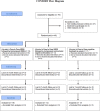Effectiveness of an Innovative Cognitive Treatment and Telerehabilitation on Subjects With Mild Cognitive Impairment: A Multicenter, Randomized, Active-Controlled Study
- PMID: 33304267
- PMCID: PMC7701275
- DOI: 10.3389/fnagi.2020.585988
Effectiveness of an Innovative Cognitive Treatment and Telerehabilitation on Subjects With Mild Cognitive Impairment: A Multicenter, Randomized, Active-Controlled Study
Abstract
Background: In recent years, the potential usefulness of cognitive training procedures in normal aging and mild cognitive impairment (MCI) have received increased attention.
Objective: The main aim of this study was to evaluate the efficacy of the face-to-face cognitive virtual reality rehabilitation system (VRRS) and to compare it to that of face-to-face cognitive treatment as usual for individuals with MCI. Moreover, we assessed the possibility of prolonging the effects of treatment with a telerehabilitation system.
Methods: A total of 49 subjects with MCI were assigned to 1 of 3 study groups in a randomized controlled trial design: (a) those who received face-to-face cognitive VRRS (12 sessions of individualized cognitive rehabilitation over 4 weeks) followed by telerehabilitation (36 sessions of home-based cognitive VRRS training, three sessions for week); (b) those who received face-to-face cognitive VRRS followed by at-home unstructured cognitive stimulation (36 sessions of home-based unstructured cognitive stimulation, three sessions for week); and (c) those who received face-to-face cognitive treatment as usual (12 sessions of face-to-face cognitive treatment as usual).
Results: An improvement in memory, language and visuo-constructional abilities was observed after the end of face-to-face VRRS treatment compared to face-to-face treatment as usual. The application of home-based cognitive VRRS telerehabilitation seems to induce more maintenance of the obtained gains than home-based unstructured stimulation.
Discussion: The present study provides preliminary evidence in support of individualized VRRS treatment and telerehabilitation delivery for cognitive rehabilitation and should pave the way for future studies aiming at identifying optimal cognitive treatment protocols in subjects with MCI.
Clinical trial registration: www.ClinicalTrials.gov, identifier NCT03486704.
Keywords: cognitive; dementia; home; mild cognitive impairment; telerehabilitation.
Copyright © 2020 Manenti, Gobbi, Baglio, Macis, Ferrari, Pagnoni, Rossetto, Di Tella, Alemanno, Cimino, Binetti, Iannaccone, Bramanti, Cappa and Cotelli.
Figures



References
-
- American Psychiatric Association (2014). DSM-5: Manuale Diagnostico e Statistico dei Disturbi Mentali. Milan: Raffaello Cortina editore.
-
- Antonietti A., Gandolla M., Rossini M., Molteni F., Pedrocchi A., Consortium A. (2016). “Interference between cognitive and motor recovery in elderly dementia patients through a holistic tele-rehabilitation platform,” in International Conference on Wireless Mobile Communication and Healthcare, Vol. 192 eds Perego P., Andreoni G., Rizzo G. (Cham: Springer; ), 359–366. 10.1007/978-3-319-58877-3_45 - DOI
-
- Bangor A., Kortum P., Miller J. (2009). Determining what individual SUS scores mean: adding an adjective rating scale. J. Usability Stud. 4 114–123.
-
- Bangor A., Kortum P. T., Miller J. T. (2008). An empirical evaluation of the system usability scale. Int. J. Hum. Comput. Interact. 24 574–594. 10.1080/10447310802205776 - DOI
Associated data
LinkOut - more resources
Full Text Sources
Medical

